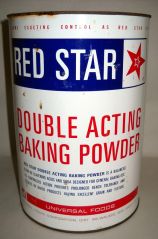 Baking powder is one of those basic ingredients that shouldn’t be complicated, right? Ah, but do you want single-acting or double-acting baking powder? Aluminum-free or not? Oh, and by the way, except for Featherweight baking powder, it’s all got cornstarch in it – rather a problem for those of us with a corn allergy. (Featherweight is made with potato starch, so if you have both corn and nightshade intolerances, avoid that product too.)
Baking powder is one of those basic ingredients that shouldn’t be complicated, right? Ah, but do you want single-acting or double-acting baking powder? Aluminum-free or not? Oh, and by the way, except for Featherweight baking powder, it’s all got cornstarch in it – rather a problem for those of us with a corn allergy. (Featherweight is made with potato starch, so if you have both corn and nightshade intolerances, avoid that product too.)
So what IS this apparently mysterious substance anyway? It’s a chemical leavener that has been around for about 150 years or so. Basically, it’s an acid substance mixed with an alkaline substance (base) in powdered form with an inert starch to absorb moisture and keep the mixture free-flowing. Remember that classic science fair project, the volcano? Baking soda is the base/alkaline substance, vinegar is the acid; put the two together and you have a volcano of carbon dioxide bubbles erupting out of your mixture. Yeah, that’s more or less what baking powder is supposed to do for your baking.
Single-Acting vs. Double-Acting
If you’ve read any recipes from our grandmothers’ era, the recipes sometimes call for single- or double-acting baking powder. That refers to when the acid-base reaction occurs during the baking process. All baking powders begin to react when exposed to moisture – even just the humidity in the air. (That’s part of why the cornstarch is added – to absorb the moisture and prevent a premature reaction.) So in single-acting baking powder, the whole reaction happens as soon as you mix the wet and dry ingredients together. That’s why you need to get your muffins in the oven as quickly as possible after mixing them up. As soon as you get the powder wet, it starts to release carbon dioxide bubbles to raise your batter. If you wait too long, the reaction will be complete, all those carbon dioxide bubbles will have escaped the batter, and you’ll have a muffin that can masquerade as a hockey puck.
Double-acting baking powder contains a second acid. This acid does not react when wet, it reacts when exposed to heat. So the first reaction occurs as the baking powder gets wet, and the second occurs as the food actually bakes in the oven. This allows you a bit more time to get your muffins in the oven, and is a little insurance against making dense little hockey pucks. Even if some of your bubbles escape before the oven, you’ve got a second chance to make more bubbles with the second acid as the batter heats in the oven. Most commercial baking powders in the US are double acting, and most recipes are written accordingly.
Aluminum-Free Baking Powder
Ok, so how does aluminum figure into all this? Well, it turns out that most of the commonly used acids in commercial baking powder contain aluminum. And since there is some connection between aluminum and neurological diseases such as Alzheimer’s, many people wish to avoid ingesting too much aluminum. Not to mention that it can impart an unpleasant flavor to your food.
What’s a baker to do? Make your own, of course. Turns out it’s really quite simple to make a single-acting, corn-free, aluminum-free baking powder.
The standard recipe is:
1 part baking soda (this is your base)
2 parts cream of tartar (this by-product of winemaking is your acid)
1 part inert starch (such as arrowroot starch or tapioca starch)
You may omit the starch if you’re not trying to store the powder for future use. Or you may double it, as you wish, just adjust your recipe accordingly. So if the recipe calls for 1 teaspoon of baking powder, use ¼ teaspoon baking soda, ½ teaspoon cream of tartar and whatever amount of starch suits your fancy. I can’t find a way to make homemade double-acting baking powder, so keep in mind that you’ll need to get that batter in the oven pretty quick if you’re using homemade baking powder.
Science! It’s what’s for dinner. Or, perhaps, dessert!


Mar 06, 2012 @ 18:03:50
This is what we do, though I never add starch or store it. I may be crazy but I think it tastes better… I feel like baking powder that has aluminum has a metallic aftertaste.
Mar 06, 2012 @ 19:21:09
Sweet! Never knew this! I’m gonna share this ok? I have a family member that’s allergic to corn starch.
Mar 07, 2012 @ 07:38:04
Of course you may share this! Avoiding corn products is difficult, and I’m sure your family member will appreciate the tip.
Dec 04, 2012 @ 20:21:22
Don’t want aluminum in my baking powder…
Aug 20, 2015 @ 18:37:11
thank you for this website. I tried a new pinterest recipe for baked wings and it called for coating the wings with baking power. my lips, gums were burned for five days ugg.
Aug 21, 2015 @ 23:27:30
Oh no! I hope that you didn’t have any further reactions, that sounds miserable.
The hardest thing about learning to cook for food allergies is learning how to read ingredients, and finding out the ingredients of the ingredients. I am so glad our little spot on the web is a help for you!
Nov 07, 2022 @ 03:25:58
Exact same thing happened. I used that recipe for crispy chicken wings on Saturday and had terrible allergic reaction. No idea cornstarch was in it.